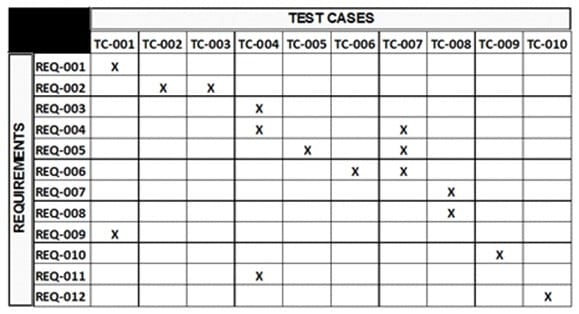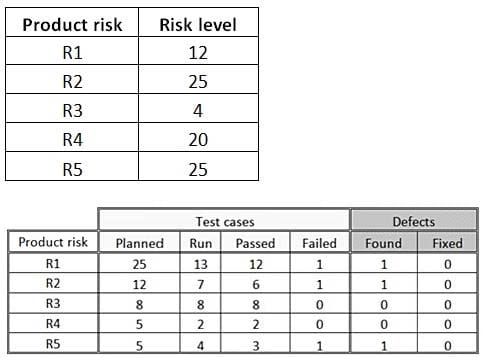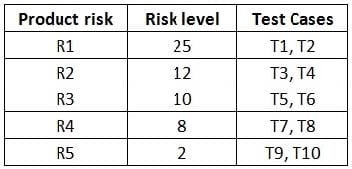Exam Details
Exam Code
:TM12Exam Name
:ISTQB-BCS Certified Tester Advanced Level- Test Manager (2012)Certification
:Test ManagerVendor
:ISTQBTotal Questions
:65 Q&AsLast Updated
:Apr 08, 2025
ISTQB Test Manager TM12 Questions & Answers
-
Question 51:
The following are the exit criteria described in the test plan of a software product:
EX1. The test suite for the product must ensure that at least each quality risk item is covered by at least
one test case (a quality risk item can be covered by more test cases).
EX2. All test cases in the test suite must be run during the execution phase.
EX3. Defects are classified into two categories: "C" (critical defect) and "NC" (non-critical defect). No
known C defects shall exist in the product at the end of the test execution phase.
Which of the following information is useless when the specified exit criteria are evaluated?
A. A traceability matrix showing the relationships between the product risk items and the test cases.
B. A list of all the open defects with the associated classification information extracted from the defect tracking system.
C. A chart, showing the trend in the lag time from defect reporting to resolution, extracted from the defect tracking system.
D. The execution status of all the test cases extracted from the test management tool.
-
Question 52:
Which of the following is an example of the test closure activity indicated as "lessons learned"?
A. Archive all the test results of the acceptance testing phase.
B. Deliver a list of the open defects of a software product released into production to the service desk team.
C. Participate in a meeting at the end of a project aimed at better managing the events and problems of future projects.
D. Deliver an automated regression test suite, used during the system test phase of a software product released into production, to the team responsible for maintenance testing.
-
Question 53:
A chart showing the trend in the lag time from defect reporting to resolution during system testing is also available. The chart shows that the daily closure period is consistently and significantly above the rolling closure period for a long period of the system testing phase.
Almost all defects found during system testing have been related to the system as a whole, not related to single units or integrations issues. Almost all quality risks have been addressed during the unit and integration testing phase and no residual quality risks were present in the integrated system. This has been confirmed by exploratory testing sessions performed during system testing, targeted at finding defects in these quality risk areas.
Based on the given information only, which one of the following areas would you expect to be considered more in the retrospective meeting in order to be improved?
A. The requirements review
B. The defect management process
C. The quality risk analysis process
D. The system design and architecture design reviews
-
Question 54:
You can count on well-written requirements, but you can't count on an adequate contribution of the stakeholders to the quality risk analysis. You have to mitigate the insufficient contribution of the stakeholders because the risk-based testing approach shall minimize the product risks. Your test team has one expert tester in security testing.
Which of the following test activities would you expect to be the less important in this context?
A. Extract from the defect tracking system of the previous project all the security defects and failures, and classify them to support design and execution of specific tests.
B. Automate all functional and non-functional system tests.
C. Apply systematic and exploratory testing for integration and system test.
D. Perform exploratory testing sessions with adequate charters covering security aspects.
-
Question 55:
Assume that the following test cases have been executed at the end of the first week of test execution: TC001, TC-002 and TC-007. All these tests are `passes'.
What is the MINIMUM number of the remaining test cases that must be successfully executed to fulfill the EX1 exit criteria?

B. 5
C. 6
D. 7
-
Question 56:
Assume that no additional product risks have been identified during the first week of test execution.

Which of the following answers would you expect to best describe the residual risks associated with the identified product risks, at the end of the first week of test execution?
A. Since R3 is the only risk for which all test cases have passed, the risk has been reduced by 20%.
B. The test execution status table indicates that the risk has been reduced by 56%.
C. The residual risk level can't be determined, because it requires that all the test cases have been executed.
D. The test execution table doesn't give an indication of the risk level of the open defects and the test cases that failed or are not run yet.
-
Question 57:
You are following a risk-based testing strategy. The test execution time is very limited. Assume that all the product risk items require more or less the same level of test effort.

Which of the following answers describes the best execution schedule in this scenario?
A. 1- Test the acceptance of transactions coming from the IVR channel 2- Test the correct charge of the Smart Card with the required contents 3- Test the correct pre-activation of the Smart Card 4- Test the correct activation of the Smart Card
B. 1- Test the correct pre-activation of the Smart Card 2- Test the correct charge of the Smart Card with the required contents 3- Test the correct activation of the Smart Card 4- Test the acceptance of transactions coming from the IVR channel
C. 1- Test the correct activation of the Smart Card 2- Test the correct pre-activation of the Smart Card 3- Test the correct charge of the Smart Card with the required contents 4- Test the acceptance of transactions coming from the IVR channel
D. 1- Test the correct pre-activation of the Smart Card 2- Test the correct activation of the Smart Card 3- Test the correct charge of the Smart Card with the required contents 4- Test the acceptance of transactions coming from the IVR channel
-
Question 58:
You are not confident with the assessment of the risk level and you suspect that it will be possible to find high-priority bugs in low-risk areas.
Furthermore, the period for test execution is very short. Your goal is to test all the product risks in a risk-based way, while assuring that each product risk gets at least some amount of testing.

Which of the following answers describes the best test execution schedule in this scenario?
A. T1, T2, T3, T4, T5, T6, T7, T8, T9, T10
B. T1, T3, T5, T7, T9, T2, T4, T6, T8, T10
C. T10, T9, T8, T7, T6, T5, T4, T3, T2, T1
D. T10, T8, T6, T4, T2, T9, T7, T5, T3, T1
-
Question 59:
The following is the unique "critical" quality risk item that has been identified:
CR-RSK-1. The GUI of the application might accept non-integer values for the input field designed to get the number of bottles from the user.
Test analysis for system testing has just begun and the following test conditions have been identified:
TC-SEL-2. Test the selection of the package sizes TC-SEL-4. Test wrong numbers of bottles for an order TC-CR-RSK-1. Test the accepted values from the input field designed to get the number of bottles from the user
Assume that you have used traceability to determine the logical test cases that cover all the requirements and the single risk item identified in that scenario.
Which of the following is a positive logical test that is complete and correct, and covers the REQ-SEL-4 requirement?
A. Select a 6-bottles package, then try to insert 5 bottles; verify that no error messages are displayed.
B. Select a 6-bottles package, then try to insert 7 bottles; verify that no error messages are displayed.
C. Select a 6-bottles package, then try to insert 7 bottles; verify that the "Invalid number of bottles" message is displayed.
D. Select a 6-bottles package, then try to insert 7 bottles.
-
Question 60:
The following are the requirements identified as "critical": REQ-SEL-001. The user shall be able to combine all the three products with all the four durations to define an item to purchase. REQ-SEL-002. The user shall be able to add a maximum of six different items to the shopping cart. REQ-PUR-001. The user shall be able to purchase all the items in the shopping cart using a credit voucher. REQ-PUR-002. The user shall be able to purchase all the items in the shopping cart using the available credit already charged on the smartcard. REQ-PUR-003. The user shall be able to purchase all the items in the shopping cart using all the accepted credit cards (Visa, MasterCard and Great Wall Card). REGLOGO-001. The user shall be able to logout (by clicking the logout button) from both the "select" and "purchase" pages going back to the "browse" page (anonymous navigation).
Moreover, the following quality risk item has been identified as "critical":
QR-P1. The web customer portal might not be able to provide the expected response time (less than 10 sec) for the purchase transactions under a load of up-to 1000 concurrent users.
Test analysis for system testing has just begun and the following test conditions have been identified:
TC-SEL-01. Test the combinations of products and durations to define an item to purchase TC-SEL-02. Test the maximum number of items, which can be added to the shopping cart TC-PUR-01. Test the purchase of an item TC-PUR-02. Test the purchase of an item with the credit charged on the smartcard
Assume that you have used traceability to determine the logical test cases that cover all the requirements and the single risk item identified in that scenario.
Which of the following is a positive logical test that is complete, is correct, and covers the REG-LOGO-001 requirement?
A. On the purchase page ("purchase state"), click the logout button; verify that the browse page ("browse state") is displayed.
B. On the select page ("select state"), click the logout button.
C. On the purchase page ("purchase state"), click the logout button; verify that the "Impossible to logout ? complete or cancel the current transaction" message is displayed.
D. On the browse page ("browse state"), click the logout button.
Related Exams:
Tips on How to Prepare for the Exams
Nowadays, the certification exams become more and more important and required by more and more enterprises when applying for a job. But how to prepare for the exam effectively? How to prepare for the exam in a short time with less efforts? How to get a ideal result and how to find the most reliable resources? Here on Vcedump.com, you will find all the answers. Vcedump.com provide not only ISTQB exam questions, answers and explanations but also complete assistance on your exam preparation and certification application. If you are confused on your TM12 exam preparations and ISTQB certification application, do not hesitate to visit our Vcedump.com to find your solutions here.